|
|
|
Sort Order |
|
|
|
Items / Page
|
|
|
|
|
|
|
| Srl | Item |
| 1 |
ID:
032382
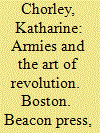

|
|
|
|
|
| Publication |
Boston, Beacon press, 1973.
|
| Description |
xii, 273p.
|
| Standard Number |
080704380X
|
|
|
|
|
|
|
|
|
|
|
|
Copies: C:1/I:0,R:0,Q:0
Circulation
| Accession# | Call# | Current Location | Status | Policy | Location |
| 013177 | 322.5/CHO 013177 | Main | On Shelf | General | |
|
|
|
|
| 2 |
ID:
026518
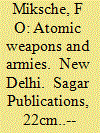

|
|
|
|
|
| Publication |
New Delhi, Sagar publications,
|
| Description |
222p.
|
|
|
|
|
|
|
|
|
|
|
|
Copies: C:1/I:0,R:0,Q:0
Circulation
| Accession# | Call# | Current Location | Status | Policy | Location |
| 000505 | 355.0217/MIK 000505 | Main | On Shelf | General | |
|
|
|
|
| 3 |
ID:
096035
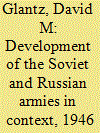

|
|
|
|
|
| Publication |
2010.
|
| Summary/Abstract |
This chronological and topical outline describes the institutional and doctrinal evolution of the Soviet and Russian Armies from 1946 through 2009 within the broad context of vital political, economic, and social developments and a wide range of important international and national occurrences. Its intent is to foster further informed discussion of the subject. Each of the article's sub-sections portrays military developments in the Soviet or Russian Armies during one of the eight postwar periods Soviet and Russian military scholars, themselves, routinely identify as distinct stages in the development and evolution of their Armed Forces. Each of the periods, argue Russian commentators, is distinguishable by a wide range of characteristics, both internal and external, that prove unique to each period.
|
|
|
|
|
|
|
|
|
|
|
|
|
|
|
|
| 4 |
ID:
131050
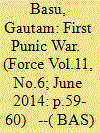

|
|
|
|
|
| Publication |
2014.
|
| Summary/Abstract |
The two leading Mediterranean powers in the post-Greek world clashed in three Punic Wars in the first of which Rome, now master of all Italy, overran Sicily, reinvented itself as a naval power and took its armies beyond Europe for the first time to Carthage in Africa
By the mid-3rd century BC, Romans had secured the whole of the Italian peninsula defeating in about 100 years every rival on mainland Italy. First the Latin League dissolved in the Latin War, then the Samnites were subjugated in three Samnite wars, and finally the cities of Magna Grecia submitted to Rome after Pyrrhus of Epirus withdrew (see FORCE May 2014). Barely decades after the last Pyrrhic War, Rome fought outside Italy for the first time. The First Punic War (264-241 BC) was the first of three fought between Carthage and the Roman Republic for supremacy in the western Mediterranean Sea. It was localised on the island of Sicily but Roman legions also landed on African soil. Carthage, located in today's Libya and Tunisia, was the world's leading naval power at that time. These wars were called 'Punic' from the Latin name for Carthaginians - 'Punici' derived from 'Phoenici' - who traced their origins to the Semitic-speaking peoples of North Africa descending from Phoenician traders of modern Lebanon and who spoke the Punic language. The Second Punic War (218-201 BC) is most remembered in military history for Hannibal's great crossing of the Alps with elephants to do what no man did before: attack Rome overland from the north. The Third Punic War (149-146 BC) involved an extended siege of Carthage, culminating in its conquest by Rome, ending the tale of one of the most illustrious military rivalries in history.
|
|
|
|
|
|
|
|
|
|
|
|
|
|
|
|
| 5 |
ID:
146531
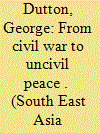

|
|
|
|
|
| Summary/Abstract |
This article examines the role and prominence of the military as the key institution of the new Nguyen dynasty in Vietnam at the beginning of the 19th century. The military had brought the new regime to power during the wars with the Tay Son regime, and the end of the conflict did not end the military’s role. I argue, contrary to existing scholarship which emphasizes the Nguyen as a civilian bureaucratic regime, that the military remained critical to the survival of the new regime. While the Nguyen slowly began the transition to civil rule, the military remained the predominant institution of the dynasty well into the middle of the century. Moreover, I argue that the regime’s military orientation had profound effects on the Vietnamese populations who were subject to conscription and the associated hardships of labor projects and suppression of insurgencies.
|
|
|
|
|
|
|
|
|
|
|
|
|
|
|
|
| 6 |
ID:
170277
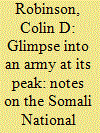

|
|
|
|
|
| Summary/Abstract |
Bagayoko, Hutchful, and Luckham correctly argue that the structures, characteristics, and operating methods of official security institutions in Africa have been somewhat neglected, with a lack of much recent research. The Somali National Army (SNA) sits among these lacunae. Its formal structures can be used as a skeletal starting point and springboard to start to draw the network diagrams that chart informal linkages. This is why recent declassification decisions by U.S. intelligence bodies, coupled with period documents released to the UK National Archives, hold significance in helping us understand early hierarchical SNA arrangements. They show the steady build-up in size of the force, to 1987, to about the time the civil war began to fragment the state.
|
|
|
|
|
|
|
|
|
|
|
|
|
|
|
|
| 7 |
ID:
024700
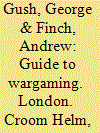

|
|
|
|
|
| Publication |
London, Croom Helm, 1980.
|
| Description |
257p.
|
| Standard Number |
0856642991
|
|
|
|
|
|
|
|
|
|
|
|
Copies: C:1/I:0,R:0,Q:0
Circulation
| Accession# | Call# | Current Location | Status | Policy | Location |
| 019043 | 355.48/GUS 019043 | Main | On Shelf | General | |
|
|
|
|
| 8 |
ID:
038073
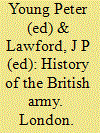

|
|
|
|
|
| Publication |
London, Arthur Barker Limited, 1970.
|
| Description |
304p.
|
|
|
|
|
|
|
|
|
|
|
|
Copies: C:1/I:0,R:0,Q:0
Circulation
| Accession# | Call# | Current Location | Status | Policy | Location |
| 005523 | 355.09941/YOU 005523 | Main | On Shelf | General | |
|
|
|
|
| 9 |
ID:
034884
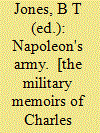

|
|
|
|
|
| Publication |
London, Greenhill Books, 1969.
|
| Description |
200p.Hbk
|
| Standard Number |
0947898778
|
|
|
|
|
|
|
|
|
|
|
|
Copies: C:1/I:0,R:0,Q:0
Circulation
| Accession# | Call# | Current Location | Status | Policy | Location |
| 029867 | 940.27/JON 029867 | Main | On Shelf | General | |
|
|
|
|
| 10 |
ID:
038071
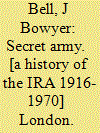

|
|
|
|
|
| Publication |
London, Anthony Blond Ltd, 1970.
|
| Description |
xiv, 405p.: ill.Hbk
|
| Standard Number |
218511191
|
|
|
|
|
|
|
|
|
|
|
|
Copies: C:1/I:0,R:0,Q:0
Circulation
| Accession# | Call# | Current Location | Status | Policy | Location |
| 005644 | 941.7/BEL 005644 | Main | On Shelf | General | |
|
|
|
|
| 11 |
ID:
032293
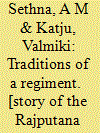

|
|
|
|
|
| Publication |
New Delhi, Lancers Publishers, 1983.
|
| Description |
xiv, 243p.
|
|
|
|
|
|
|
|
|
|
|
|
Copies: C:1/I:0,R:0,Q:0
Circulation
| Accession# | Call# | Current Location | Status | Policy | Location |
| 021161 | 355.310954/SET 021161 | Main | On Shelf | General | |
|
|
|
|
| 12 |
ID:
161349
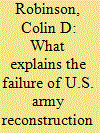

|
|
|
|
|
| Summary/Abstract |
This author wrote his doctorate thesis on post-conflict army reconstruction, submitting it in 2011. Continued research on the subject in the intervening seven years indicates that his theoretical propositions can be refined and improved. This article examines refinements to the model, and then applies those refinements in detail to the Afghan case. In so doing, it shifts the focus from potentially altruistic state-building to a case that was driven by pure national-strategic interests. Issues surrounding the liberal peace ideology dominate recent army reconstruction in conflict-affected states. The liberal peace underpinning is of supreme importance, so much so that in many discussions, it is internalised and accepted virtually without thought. This paper will advance the body of knowledge by establishing, for the first time, a theoretical basis for the widespread failure of army reconstruction in Afghanistan. The empirical basis builds on extensive previous research by other scholars. The resulting model can also be applied to better explain outcomes in other similar cases.
|
|
|
|
|
|
|
|
|
|
|
|
|
|
|
|
|
|
|
|
|